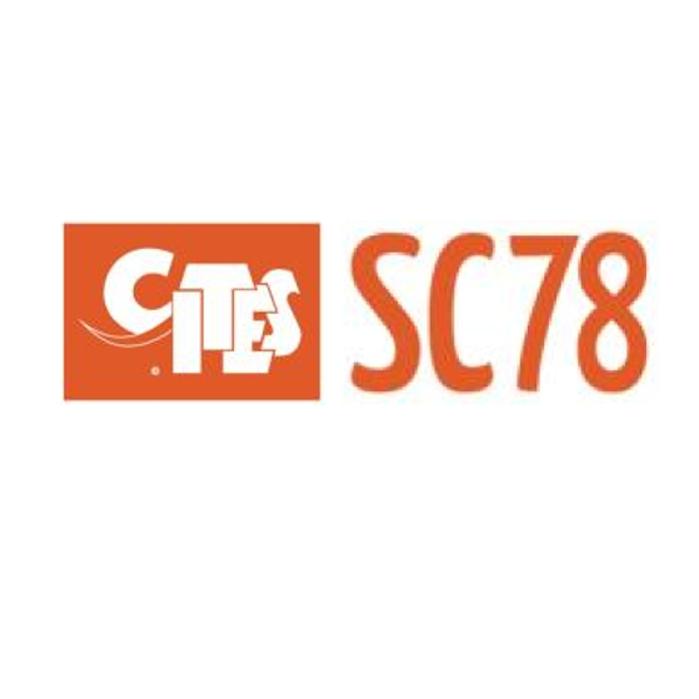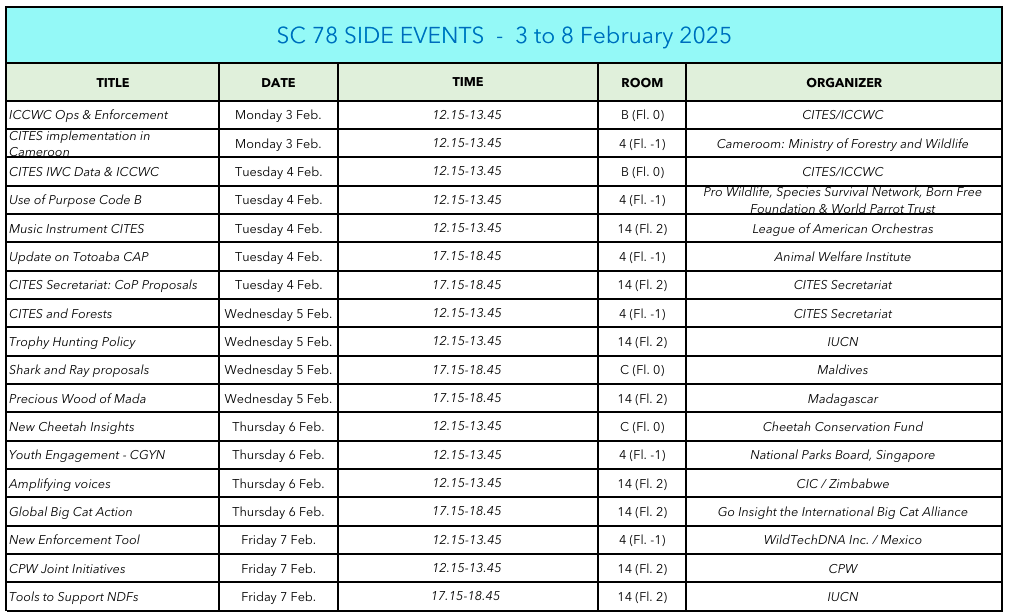
CITES 78th Standing Committee meeting
Geneva
Switzerland
Seventy-eighth meeting of the Standing Committee of the Convention on International Trade in Endangered Species of Wild Fauna and Flora (CITES)
The Standing Committee is the senior committee of the agreement comprised of representatives from each of the six CITES geographical regions, responsible for providing guidance to the Secretariat regarding CITES implementation and management of the Secretariat's budget.
AWEI is observing the discussions relevant to guidance for non-detriment findings and participating in two side events: Trophy Hunting Policy and Amplifying the Voices.
Presentations from the side events available further below
Key agenda items relevant to the wildlife economy
- 6. Report of the Chairs of the Animals and Plants Committees
- 14. CITES Strategic Vision
- 18. World Wildlife Trade Report
- 27. Engagement of Indigenous Peoples and Local Communities
- 28. Livelihoods
Key issues relevant to the wildlife economy
- Mapping the CITES Strategic Visions against the Global Biodiversity Framework, notably Targets 5 and 9 on wildlife use and trade
- Efforts by CITES Parties to ensure sustainable use of CITES-listed species
- An improved monitoring mechanism to assess whether CITES was achieving its objectives and to identify any gaps to ensure that the trade would be legal and sustainable
- Support the participation of Indigenous peoples and local communities in international commercial trade in CITES-listed species

Key side events
Trophy Hunting Policy (IUCN)
05 Feb 2025 - 12:15-13:45 - Room 14
As of late 2024, 11 counties in the Global North have either enacted, or are considering enacting, import bans on hunting trophies, including from CITES-listed species. These stricter domestic measures risk undermining successful conservation models and the role of indigenous peoples and local communities in implementing CITES in different parts of the world including South Asia and southern Africa among others.
This side event will present case studies which demonstrate the positive role that trophy hunting and associated trade play in supporting biodiversity conservation. It will also present recent analyses on the threat to species from trophy hunting – or lack thereof – and the implications for future policy making both within CITES and by Parties using stricter domestic measures. Feedback on the rationale for such measures will be invited from relevant importing countries. It relates to the following agenda items: 27. Engagement of indigenous peoples and local communities, and 28. Livelihoods.
- Introduction to the session
Dr Dilys Roe, Chair IUCN SULi (Facilitator) - Are proposed import bans on hunting trophies proportionate? [Presentation]
Dr Dan Challender, Senior Research Fellow, University of Oxford
Proposed import bans on hunting trophies
What does key evidence show? Insights from CITES Trade Data and the IUCN Red List
Potential impact of import bans
Implications for public policymaking - Trophy hunting and its benefits in Zimbabwe
Dr Patience Gandiwa, Director of TFCAs & Conventions, ZimParks
How trophy hunting works and is managed in Zimbabwe
The benefits trophy hunting brings to Zimbabwe and her people
Implications of import bans for Zimbabwe - Trophy hunting and its benefits in Namibia [Presentation]
Mr Colgar Sikopo, Director of Wildlife Services and Park Management, Ministry of Environment and Tourism
How trophy hunting works and is managed
The benefits trophy hunting brings to people
Implications of import bans - The impact of trophy hunting bans on CITES and multilateralism [Presentation]
Dr Francis Vorhies, Director, African Wildlife Economy Institute, Stellenbosch University
The impact of import bans on hunting trophies for CITES
The impact of import bans on hunting trophies for multilateralism - Q&A and discussion
Amplifying the Voices (Zimbabwe)
06 Feb 2025 - 12:15-13:45 - Room 14
Indigenous Peoples and Local Communities (IP&LCs) are at the forefront of biodiversity conservation and the sustainable use of CITES-listed species. Their traditional knowledge, practices, and community-led initiatives are indispensable for achieving conservation goals. However, IP&LCs' participation in decision-making processes under CITES remains limited, despite progress made by two dedicated CITES working groups on IP&LC engagement and livelihoods. This side event aims to provide a community-driven platform where IP&LCs lead discussions on their contributions, challenges, and recommendations for meaningful engagement within CITES.
This session will:
- Showcase IPLC Leadership: Allow IP&LCs to highlight their experiences and strategies for biodiversity conservation and sustainable use.
- Identify the practical ways forward: Distinguish the unique needs and priorities of Indigenous Peoples and Local Communities as separate but interconnected groups. Highlight concrete practical examples of their meaningful engagement within CITES processes.
- Share Working Group Progress: Present updates on guidance and recommendations for strengthening IP&LC engagement.
- Foster Collaborative Dialogue: Facilitate a community-driven discussion on actionable steps for enhancing IP&LC representation and participation in CITES processes.
- Highlight lessons learned from other MEAs, where IP&LCs play a formalized role in decision-making.
The side event relates to the following agenda items: 27. Engagement of indigenous peoples and local communities, and 28. Livelihoods.
-
Moderator
Mr Sebastian Winkler, Director General, International Council for Game and Wildlife Conservation (CIC) - Panel
- Dr Patience Gandiwa, Director of International Conservation Affairs, ZimParks
Practical community engagement in CITES processes
Challenges and barriers IP&LCs face in CITES decision-making
Pathways to integrate IP&LC voices meaningfully in governance structures - Ms Lusizi Mwale, Principal Warden Conservation, Zambia [Presentation]
Increasing IP&LC visibility and influence within CITES
Enhancing national-level engagement and capacity building for communities
Successful community-led conservation initiatives - Ms Carolina Caceres, Canada, Chair of CITES Indigenous People and Local Communities Working Group
Perspectives from the Working Group on the best methods to engage the IP&LCs
Building momentum for an IP&LC advisory mechanism or platform at COP20. - Dr Dilys Roe, Chair IUCN SULi, Vice-chair of CPW [Presentation]
IUCN SULi perspectives on the technical ways of IP&LC engagement in CITES
Lessons learned from other processes where IP&LCs play a formalized role in decision-making - Dr Francis Vorhies, Director, African Wildlife Economy Institute, Stellenbosch University
IP&LC engagement with Management Authorities at the national level
Facilitation of sustainable and legal trade of wildlife products from CITES-listed species
- Dr Patience Gandiwa, Director of International Conservation Affairs, ZimParks
- Closing remarks
Ms Ivonne Higuero, Secretary General of CITES, Chair of CPW - Q&A and discussion
Related links
Related content
Get updates by email
Through impactful research, stakeholder engagement, and professional development, AWEI is supporting the wildlife economy across Africa. Please subscribe for occasional updates on our work and forthcoming events.
Sign up for a quarterly dose of AWEI insights
In a complex and changing world, AWEI generates strategic ideas, conducts independent analysis on wildlife economies, and collaborates with global scholar-practitioners to provide training and expertise for biodiversity conservation, climate resilience, and inclusive economic opportunities in Africa.
